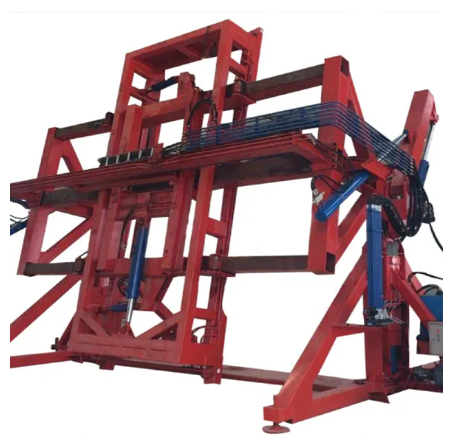Essential Container Unloading Equipment for Safety and Efficiency
Forklifts and Pallet Jacks
Forklifts play a vital role in handling those heavy containers without putting workers at risk from lifting injuries. These machines cut down on the physical strain of moving large loads around warehouses and loading docks. Getting the right type of forklift matters a lot because different models handle varying weights and navigate warehouse layouts differently. Some warehouses might need something with higher lifting capacity while others require better turning radius for tight corners. Pallet jacks come into their own when dealing with smaller loads or navigating through narrow aisles where bigger machinery just won't fit. Even though they require manual effort, these hand operated devices can move pallets around storage areas much faster than trying to squeeze a full sized forklift into confined spaces. The combination of both equipment types creates a more efficient workflow system across most industrial settings.
Cranes and Hoisting Systems
Cranes play a critical role in moving those big, heavy containers that regular forklifts simply can't handle. Think about shipping containers weighing several tons each or industrial equipment too bulky for standard warehouse machinery. These machines make sure even the toughest loads get lifted and positioned without incident. Most modern hoisting systems come equipped with automated controls these days, which cuts down on mistakes people might make when manually operating lifting gear. Industry data shows cranes stay dependable over time if maintained properly according to schedule. We've seen facilities run their crane operations smoothly for years with just routine checks and occasional part replacements. For companies serious about workplace safety and wanting to boost productivity at the same time, investing in quality crane systems pays off handsomely in both accident prevention and operational efficiency gains.
Conveyor Belts and Roller Systems
Conveyor belts have become essential for unloading operations these days. They boost efficiency simply because they keep those containers moving from one spot to another without all that wasted waiting around. Workers don't have to lift as much stuff manually, which means less sore backs at the end of the day and faster turnaround times overall. Roller systems work pretty well too, letting materials slide along smoothly instead of requiring people to drag things across floors. Some studies indicate companies using automated conveyors might save around 30% off their unloading times when compared with old school manual approaches. That kind of time savings makes it possible to shift staff around to other tasks where they're needed most throughout the facility.
Vacuum Lifters and Robotic Assistants
Vacuum lifters play a really important part when it comes to moving delicate items that need special attention so they don't get damaged during transport. We see them working wonders in places like pharmaceutical warehouses and electronics manufacturing facilities where even the slightest mishandling could spell disaster for valuable goods. Meanwhile robots have become game changers too. They take over those boring, repetitive jobs around the clock without getting tired or making mistakes. The numbers back this up pretty well actually. When factories start bringing in robotic arms for bulk unloading operations, we typically notice around a 35-40% jump in overall efficiency. Both these technologies mark major progress in automated container handling systems. Businesses can now process way more cargo while still keeping things safe and productive across their operations.
Safety Protocols for Operating Container Unloading Machinery
Personal Protective Equipment (PPE) Requirements
Wearing proper PPE remains non-negotiable for anyone working around container unloading equipment. Helmets protect against falling objects, thick gloves prevent hand injuries from sharp edges, and steel-toed boots guard feet during those inevitable slips near cargo areas. Companies that really enforce their PPE rules tend to see fewer incidents on site. One major shipping company reported cutting their injury rate almost in half after tightening up their gear policies last year. Regular refresher courses help keep everyone on track with safety standards. These trainings aren't just check-the-box exercises either they actually demonstrate how to properly adjust harnesses, inspect gear for wear, and recognize when equipment needs replacing. The result? Fewer trips to the infirmary and a workforce that genuinely cares about staying safe while doing the job right.
Regular Maintenance Checks for Heavy Equipment
Regular maintenance checks on heavy equipment really matter if we want these machines to last longer and avoid dangerous breakdowns. When businesses stick to good maintenance schedules, they tend to see fewer days when equipment sits idle, which means workers can get things done faster. The folks at OSHA definitely push for strict maintenance routines as part of keeping workplaces safe. Companies that take time to look over and service their machines regularly end up with safer operations overall while getting better performance from their gear too. Equipment runs smoother and stays dependable day after day when proper care is given.
Operator Training and Certification Standards
Training and certifying workers who operate container unloading machines isn't just good practice it's absolutely necessary for keeping operations running safely and efficiently. Workers who get thorough training actually learn how all the parts work together, which cuts down on accidents at work sites. Getting certified by respected industry groups acts like proof that someone knows what they're doing and follows proper safety rules. The National Safety Council has some numbers showing this too trained workers make workplaces safer overall while making things run better too fewer mistakes happen when people know their stuff. Employers really should think about investing money into regular training sessions and certification courses. A team that knows their job well creates a safer environment, works faster, and stays within all those complicated industry regulations without breaking a sweat.
Advanced Automation Solutions in Modern Container Unloading
AI-Powered Robotic Unloading Systems
Robotic systems powered by artificial intelligence are changing how containers get unloaded from ships and trucks across major ports worldwide. These advanced machines look at what needs to be done during unloading and adjust on the fly, which makes everything run smoother than traditional methods. When companies install these kinds of systems, they save money on staffing while cutting down mistakes that happen when humans do all the work manually. Some studies show that automated solutions in shipping and receiving areas can actually increase container processing speeds by around 25 percent. For businesses trying to improve their bottom line without sacrificing quality, bringing AI robots into warehouse operations really helps things move faster and keeps production numbers higher than before.
Automated Guided Vehicles (AGVs)
AGVs have become essential in container unloading operations these days, moving around warehouses on their own to carry goods from one place to another. These machines are built to handle really heavy stuff, which cuts down on workplace injuries that often happen when people lift containers manually. Some warehouse managers report seeing unloading times drop almost half when they switch from old school methods to AGVs. Companies that bring these vehicles into their operations tend to see better safety records overall, plus workers aren't as stressed about lifting heavy boxes all day long. Many logistics firms now consider AGVs not just helpful but necessary for keeping up with demands in today's fast paced supply chain environment. They make things run smoother and keep everyone working in the facility much safer.
Sensor-Based Load Monitoring Technology
Load monitoring tech using sensors is changing the game for container unloading operations by giving workers instant information on what's actually inside those containers. These systems stop overloading before it happens, something that can save lives when containers tip or collapse. The sensors collect all sorts of useful data points that help managers tweak their unloading procedures, which means fewer delays and safer work environments. Studies indicate that adding these sensors to cargo handling cuts down accidents roughly 30% across different ports. Companies that adopt this tech find they get better safety records while their crews move goods faster because everyone knows exactly what they're dealing with at any given moment. That's why more logistics firms are investing in sensor networks despite the upfront costs.
Best Practices for Efficient Container Unloading Operations
Optimizing Loading Dock Layouts
When it comes to getting containers off trucks efficiently, having a good layout at the loading dock makes all the difference. Proper planning means fewer bottlenecks and smoother workflow overall. There are several things worth considering when setting up a dock area. First, where those doors are placed matters a lot for making sure trucks can get in and out without hassle. Then there's the height issue since different vehicles need different clearance levels. And let's not forget about leaving enough room around so forklifts and other equipment can move freely without getting stuck. Getting these basics right really pays off. Some studies indicate that smart layout design can cut down unloading time by as much as twenty percent. Warehouses that pay attention to these details tend to handle their daily cargo volume much better, especially during peak seasons when everything seems to arrive at once.
Implementing Real-Time Inventory Tracking
Having real time inventory tracking makes all the difference when it comes to getting goods off trucks and stored properly. When managers can see exactly what's on hand right now, they avoid those frustrating situations where someone thinks there's product available but it turns out to be gone. Companies that have invested in tech solutions for instant updates report fewer mistakes overall. We've seen warehouses cut down on misplaced or lost items by quite a bit after implementing these systems. Some market research suggests around 15% improvement in how efficiently operations run once real time tracking is in place. Beyond just making things more accurate, these systems actually change how storage works day to day. The whole supply chain becomes less chaotic and more adaptable to sudden changes in demand.
Weatherproofing Strategies for Outdoor Unloading
Keeping gear and materials safe during outdoor loading when bad weather hits really matters. Simple things like covering loads with tarps or setting up temporary shelters makes a big difference in avoiding delays caused by rain, snow or wind. Some studies have found that businesses spending money on good weather protection see around 25 percent fewer problems from bad weather messing up operations. For warehouse managers dealing with unpredictable conditions day after day, implementing basic weatherproofing measures pays off in terms of getting shipments moved on time and keeping the whole operation running without unnecessary interruptions.
FAQ
Why are forklifts important in container unloading?
Forklifts are essential because they manage heavy containers safely, reduce manual labor, and improve efficiency with their load capacity and maneuverability.
How do cranes enhance container unloading operations?
Cranes handle large and unwieldy containers safely and efficiently, proving reliable when properly maintained, making them a smart investment for safety and efficiency.
What role do AI-powered robotic systems play in container unloading?
AI-powered robotic systems enhance container unloading by optimizing processes, reducing labor costs, minimizing human error, and increasing handling capacity by up to 25%.

